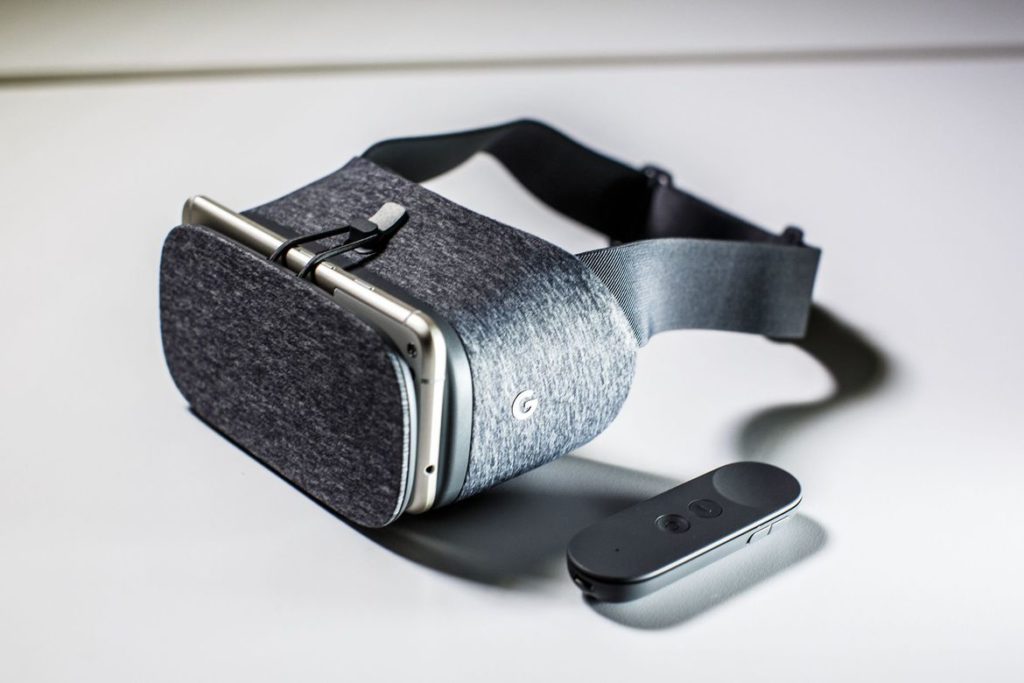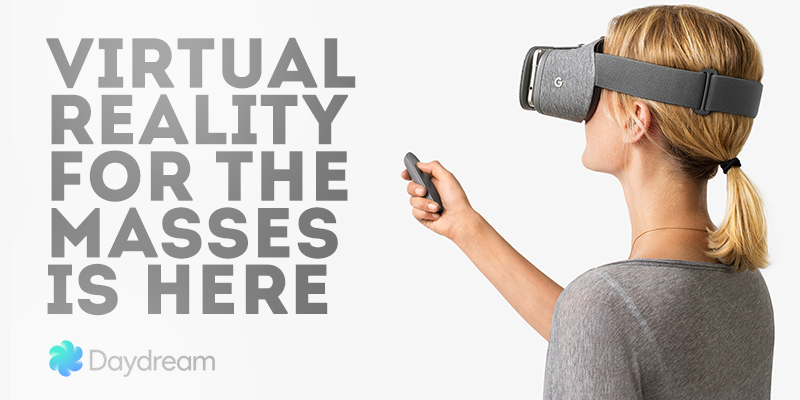Although it was just announced a short time ago at the 2016 Made by Google event, the new Daydream VR platform is already making big waves in the tech industry. The Daydream View head-mounted display, along with the Pixel phones that fit it, represent a radical shift in design philosophy for Google.
Daydream View, unlike Gear VR and very much unlike high-end headsets like the Oculus Rift and HTC Vive, was conceived and built from the ground up for mass appeal and mass adoption. The headset, with its sleek looks and unique fabric construction, is an appealing contrast to the stark plastic and metal of most other headsets.
In terms of mass market appeal, Daydream View represents a leap even over Cardboard, Google’s last foray into “VR for everyone.” The issue with Cardboard, analysts now agree, was that it leaned too hard into its low price point and simplistic feature set.

Google Daydream View - virtual reality headset.
Source: CNET.com
At SuperData, a market analysis firm specializing in the gaming industry, Stephanie Llamas described how consumers came to view cardboard as “a device that is literally disposable and has largely been dismissed by now as a novelty item.” In other words, Cardboard was too cheap to have a perceived value.
Daydream View, on the other hand, is just right. It’s priced below Samsung Gear VR, with comparable or superior technology. More importantly, it has a revolutionary design aesthetic that makes people want to use it, and use it for long periods of time. Perhaps most important of all, it has all the considerable weight of Google’s marketing and business development teams behind it.
A Design Revolution at Google
When Google VP of Virtual Reality Clay Bavor gently lifted a Daydream View out of its box and let the world see it for the first time, an audible gasp came from the audience at the Made by Google keynote. Daydream View simply doesn’t look like a VR headset as we know it. It’s soft. It looks nice. It looks comfy. Fashionable, even.
This new direction in the physical design of headset is entirely on purpose. Bavor said it best when he said one of the first questions his design team asked was “What would people actually want to wear on their heads?”
Google partnered with an unnamed athletic apparel firm to develop a high-performance textile for Daydream View. In the world of textiles, “high-performance” means that the material is durable and sweat-resistant, able to be worn comfortably for long periods of time. Anyone who has spent time in VR knows how unpleasant those face pads can be after a while.
By prioritizing comfort, Google has ensured that people will actually enjoy using Daydream View, long after the initial novelty of the device has worn off.
It’s a practical choice that makes the headset a viable piece of everyday kit. It’s not unreasonable to expect people to carry a Daydream View around in their purses or briefcases. Google even built a holder for the controller into the headset, creating a compact package that anyone can pull out at a moment’s notice to check out a new experience, game, or app.
This is Google taking a page from Apple’s book, which has always understood the value of looks and comfort, even over tech and features. It’s a change for the better.
The Pixel Boost
Speaking of Apple, Pixel is the new Google phone, and it has more than a couple of things in common with the iPhone. Pixel is the first phone designed and branded in-house, under the leadership of Head of Hardware Rick Osterloh, a veteran of Motorola.
Osterloh made a lot of changes when he stepped in, but the biggest one was instilling a sense of intention to Google’s hardware operations. Google is a company that is known for throwing dozens of disparate projects into the air and seeing what catches on. Project Ara, iGoogle, Buzz, and countless more hardware and software endeavors have been launched, tried, and simply canceled without much fanfare.
Google Pixel phones with VR support.
Source: Wired.com
That’s not the case anymore. Osterloh understands the need for synergy and cooperation among the vast number of products the company develops and releases. In an interview with The Verge, he said “It’s very challenging to work on dozens of products and make them all terrific. We have to have a lot of discipline and a lot of focus.”
Therefore, we can expect the Daydream View market share to grow almost as fast as Pixel’s. Google is making it clear that Daydream is more than a novelty. It’s a piece of the Pixel experience that is genuinely enjoyable and useful, and for only a small additional fee to buy the headset, anyone can take advantage of it.
Experiences and Partnerships
Of course, hardware is only a piece of the puzzle when it comes to a successful product. The software, in this case apps, games, and experiences, are arguably more important. True mass market acceptance requires enough content to please everyone, and to keep them interested over a long period of time. A few flashy apps on launch are not enough, as people will invariably get tired of them and move on to another platform.
In order to prevent that, Google has dedicated an entire team to developing relationships with content creators. Director of AR/VR Business Development Adrienne McCallister works with organizations ranging from game developers to museums and press outlets to help them bring quality apps to the Daydream platform. Google is committed to quality, and new developers must undergo an approval process, much like on the Apple App Store.
How to Make a VR App for Google Daydream
Now is a good time to prepare and get into Daydream app development, as it will be a lucrative and profitable endeavor for current Android developers…
The opportunities here are clear. Google is actively seeking out content providers to flesh out the software available on the Daydream platform. The time is ripe for visionaries with ideas for high-quality VR experiences to approach Google, get approved, and start releasing Daydream apps. Conservative estimates place the number of Daydream View owners at half a million by the end of 2016, and 14 million by 2020.
With the help of an experienced VR development firm, those visionaries need not have internal development capabilities. Launch apps for Daydream include offerings from the New York Times and the London Natural History Museum, certainly not organizations known for their programming skills. Contracting development duties to an external firm is a proven strategy, with the client providing direction on the content and flow of the app, and the development firm executing on that direction.
How to Get Your Slice of VR Pie?
AppReal-VR, as an acclaimed outsourcing software development house with years of experience in VR and AR, is an ideal VR development partner. The Ukraine-based firm has worked with happy clients around the world and in many industries.
The company is guided by the leadership of CEO Yariv Levski, a veteran of countless IT and development projects. Overall, the company has created tens of VR and AR apps for clients ranging from tiny startups to established corporations.
AppReal-VR is expert in the use of cutting-edge technologies, and is very accustomed to working in uncharted territory. Google Daydream is brand new, and its boundaries are not yet set. AppReal-VR is the perfect partner to help push those boundaries.



You made an error in your title. It should be something like: “Why is Google x?” or just “Why Google is x.” The mixed “Why Google is x?” is just terribly unprofessional in how poor English it is. 😉